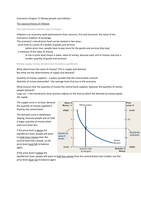Summary
Economics summary chapter 27 Money growth and inflation
- Course
- Institution
- Book
Summary of chapter 27 of the book Economics. Written by N. Gregory Mankiw and Mark P. Taylor, 3rd edition. Written for IBMS students of Avans or for the course Economics. ISBN 9781408093795.
[Show more]




